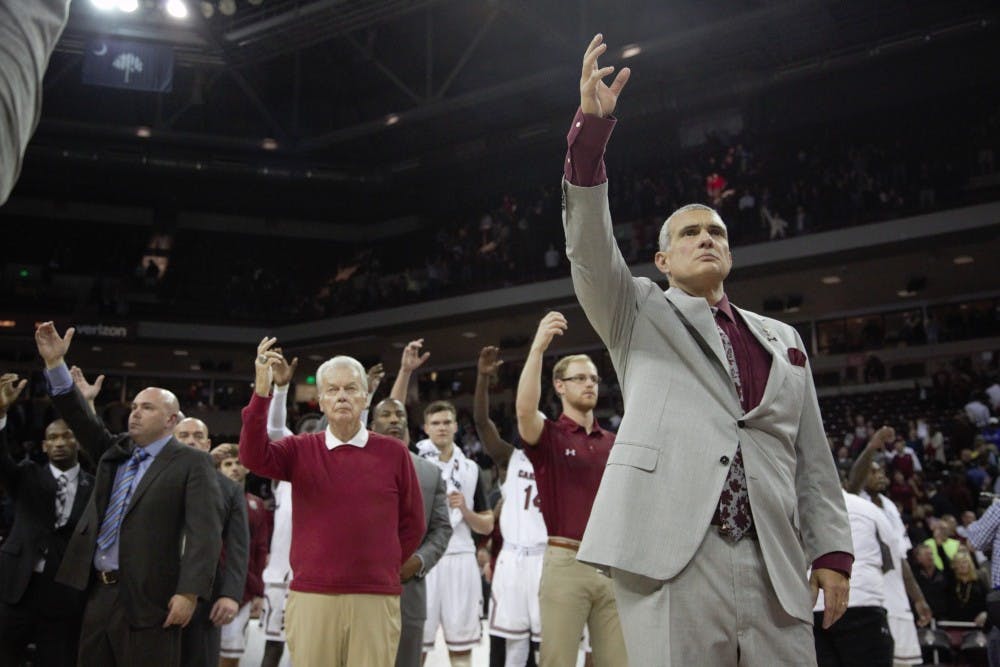Frank Martin generally isn't one to mince words, and that held true in a recent story published by CBS Sports, when South Carolina's head man discussed a hot-button topic, the role of college basketball when it comes to putting players in the NBA.
The NBA's age limit of 19 and requirement of one year after high school graduation puts college coaches in a tough position, as elite prospects are filtered through the NCAA quickly, as we've seen in the one-and-done era. In his five years at South Carolina, Martin has only lost one player early to the NBA Draft: PJ Dozier, who left after his sophomore season and is projected as a second-round pick in Thursday's draft. However, Martin shares the conference with Kentucky's one-and-done guru John Calipari, who has seemingly perfected his system of grabbing elite high school talent with the promise of converting players into lottery picks. Calipari has been the revolutionary of the era, as 14 Kentucky players have been selected in the lottery over the past seven drafts, and at least two, if not three, more should join that group this week.
Martin and Calipari were both quoted in the CBS article supporting the NBA going back to the old rules and allowing players to be drafted straight out of high school, a system that ended after the 2005 draft, forcing elite talents Kevin Durant and Greg Oden into going to college rather than being eligible in 2006.
“I get frustrated with the way everything is spun,” Martin said. “Everyone wants to blame college basketball, that we’re using these kids. They need to be mad at the NBA that they prevent these kids from going to work."
This debate is one that generally centers around the elite high school players, players like Karl-Anthony Towns and Ben Simmons, which makes sense. Highly-touted players who skipped college have enjoyed success in the NBA, most notably LeBron James, Kevin Garnett, Tracy McGrady and Kobe Bryant. There have been several high-profile flops as well, such as Jonathan Bender, the fifth pick in 1999, or Darius Miles, the third pick in 2000. (Who? Exactly.)
As Martin pointed out, this doesn't have to be just a discussion for the players who could become lottery picks. In 2005, six high schoolers were drafted in the second round, four of whom are still in the NBA, now having played 12 seasons, which is far longer than the average career.
"Whoever wants to be in college, come on," Martin said. "Whoever wants to be a pro with this great D League and all these two-way contracts, go. Go. Go. They can go and play in front of 150 people.”
College certainly isn't for everyone, and if players have the talent to make an NBA (or D-League) roster and make money, I don't see a reason to stop them. Even NBA Commissioner Adam Silver said on June 1 that the current system isn't working for anyone.
A big part of Martin's point is that players who come to college should be doing it to play basketball and get an education, while staying for four years, like South Carolina's Sindarius Thornwell. Thornwell is one of several players in recent years who has dramatically boosted his draft stock during his senior year, while also earning his degree, joining players like Buddy Hield and Denzel Valentine, both lottery picks in 2016.
Martin didn't suggest implementing a system requiring college players to stay in school for all four years, but he seemed to believe it would be in their best interest to do so. Requiring it may be a stretch, as circumstances can change (new coach, financial crisis, etc.), but Martin made it clear that he believes college basketball isn't a "minor league" for the NBA.
And he's right. The NBA has its own minor league, the D-League... well, the G-League, as it will be known next season. Regardless, Martin is one of several college coaches who thinks college basketball's system should be a lot more like baseball, and less like football.
In college baseball, players are allowed to forgo college and sign with a major league organization immediately after high school, sometimes as young as 17 years old, as was the case with Hunter Greene, the second pick in last week's MLB Draft. Players can go the junior college route as well, but if they pick a Division I school like South Carolina, there is a draft entry age limit of 21, which generally keeps players in college for at least three years.
Changing the rules would actually be good for college basketball. Though we would never have gotten to see players like Lonzo Ball or Anthony Davis touch a college basketball court, the competitiveness of the sport would increase if players were staying in school. Not only would the product improve as well, but spending more time in college would help turn these athletes into better young men, better equipped to handle the spotlight of the NBA if it comes calling.
And that's Frank Martin's job too.

